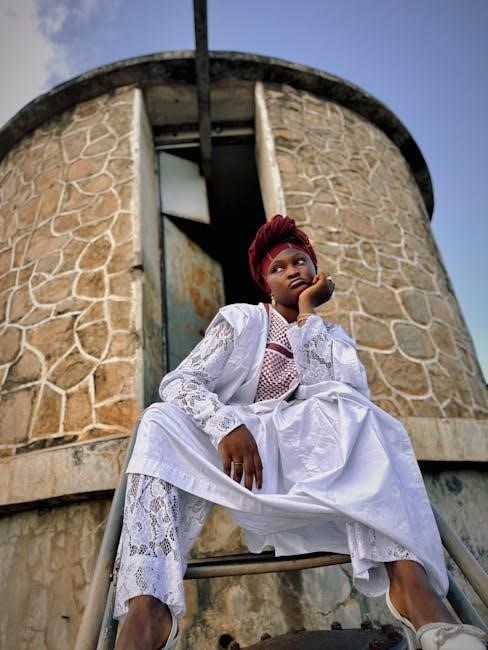The Polyvagal Theory, developed by Dr. Stephen Porges, explains how the autonomic nervous system regulates safety, emotional responses, and social interactions through the vagus nerve.
1.1 Overview of the Polyvagal Theory and Its Significance
The Polyvagal Theory, developed by Dr. Stephen Porges, revolutionized understanding of the autonomic nervous system’s role in emotional regulation, social connection, and survival responses. It emphasizes the vagus nerve’s function in detecting safety and modulating reactions to threats, providing a foundational framework for addressing trauma, anxiety, and interpersonal dynamics. This theory has become pivotal in therapy and personal development, offering insights into how individuals respond to and recover from stress.
1.2 The Role of the Vagus Nerve in Emotional Regulation
The vagus nerve plays a critical role in emotional regulation by connecting the brain to the body. It facilitates communication between the central nervous system and various organs, influencing heart rate, breathing, and stress responses. According to the Polyvagal Theory, the vagus nerve helps detect safety, enabling relaxation, while also activating survival responses when threats are perceived. This dual function is essential for maintaining emotional balance and physical well-being.
Understanding the Autonomic Nervous System (ANS)
The ANS regulates involuntary bodily functions like heart rate and digestion. It includes the sympathetic (fight/flight) and parasympathetic (rest/digest) systems, crucial for responding to threats and promoting relaxation.
2.1 The Three Main Responses of the ANS: Fight, Flight, and Freeze
The ANS triggers three primary responses: fight, flight, and freeze. Fight involves aggressive action, flight is about escaping danger, while freeze is a last-resort immobilization. These responses are adaptive, ensuring survival by reacting to perceived threats. Understanding these mechanisms is key to grasping how the nervous system prioritizes safety and reacts under stress. These responses are fundamental to the Polyvagal Theory framework.

2.2 The Connection Between the ANS and Emotional States

The autonomic nervous system (ANS) plays a crucial role in linking emotional states to physiological responses. The vagus nerve, central to the Polyvagal Theory, regulates how we experience and express emotions. Emotional states like calmness or anxiety are directly tied to the ANS’s response modes, such as ventral vagal safety or sympathetic arousal. Understanding this connection helps in managing emotional health and fostering resilience.
The Concept of the Polyvagal Ladder
The Polyvagal Ladder is a model based on Dr. Stephen Porges’ Polyvagal Theory, helping individuals understand and navigate their autonomic nervous system states for better emotional regulation and safety.
3.1 What is the Polyvagal Ladder?

The Polyvagal Ladder is a visual representation of the autonomic nervous system’s hierarchy, developed by Deb Dana. It illustrates three main states: Ventral Vagal (safety), Sympathetic (fight/flight), and Dorsal Vagal (freeze). This tool helps individuals recognize their current state and move towards regulation, enhancing emotional resilience and social engagement through self-awareness and intentional practices.

3.2 How the Polyvagal Ladder Helps in Self-Regulation
The Polyvagal Ladder aids self-regulation by helping individuals identify their current autonomic state and strategically shift to a safer, more regulated state. By recognizing signs of sympathetic activation or dorsal vagal immobilization, one can employ practices like deep breathing, grounding, or social connection to ascend the ladder, fostering resilience, emotional balance, and improved responses to stress or challenges.

The Structure of the Polyvagal Ladder

The Polyvagal Ladder consists of three tiers: Ventral Vagal (safety and connection), Sympathetic (fight/flight), and Dorsal Vagal (freeze), reflecting autonomic responses to emotional and environmental cues.

4.1 Ventral Vagal: The Top of the Ladder
The Ventral Vagal complex represents the highest level of nervous system functioning, characterized by safety, connection, and social engagement. It enables empathy, communication, and emotional regulation, facilitated by the vagus nerve. This state allows for calmness and resilience, making it the optimal condition for well-being. When activated, it supports healthy relationships and adaptive responses to challenges, fostering a sense of security and balance in daily life.
4.2 Sympathetic: The Middle of the Ladder
The Sympathetic response, situated in the middle of the Polyvagal Ladder, represents the body’s “fight or flight” reaction. Activated when safety is uncertain, it prepares the body for action by increasing heart rate and tension. This state is adaptive for immediate threats but can lead to chronic stress or anxiety if prolonged. Recognizing this state is key to managing stress effectively and returning to a regulated state. It highlights the body’s natural survival mechanisms while emphasizing the need for balance in emotional and physiological responses. Understanding the Sympathetic response aids in developing strategies to transition back to the Ventral Vagal state for overall well-being.
4.3 Dorsal Vagal: The Bottom of the Ladder
The Dorsal Vagal response is the most primitive state, located at the bottom of the Polyvagal Ladder. It represents the body’s “freeze” or immobilization response, often triggered by extreme threat or danger. This state is characterized by disconnection, numbing, and reduced physiological activity. It is a survival mechanism but can hinder recovery and emotional processing if chronically activated. Understanding this state is crucial for addressing deep-seated trauma and fostering resilience. By recognizing the Dorsal Vagal response, individuals can develop tools to move up the ladder, reconnect, and restore balance to their nervous system. This awareness is vital for healing and achieving a regulated state, allowing for improved emotional and physical well-being. It underscores the importance of self-awareness and tailored interventions to support recovery and growth. The Dorsal Vagal response serves as a foundational aspect of the Polyvagal Theory, highlighting the interconnected nature of safety, threat, and emotional regulation. It emphasizes the body’s innate responses and the need for compassionate, informed strategies to navigate and manage these states effectively. Through this understanding, individuals can better navigate their emotional landscapes and cultivate resilience in the face of adversity. This response is a critical component of the Polyvagal Ladder, offering insights into the body’s hierarchical response to safety and danger. It also underscores the importance of the Vagus Nerve in regulating these responses and promoting overall well-being. By addressing the Dorsal Vagal state, individuals can work towards healing and integrating their experiences, leading to a more balanced and regulated nervous system. This process is essential for fostering resilience and improving quality of life, as it allows individuals to move beyond survival responses and engage fully in their lives. The Dorsal Vagal response, while adaptive in extreme situations, highlights the need for awareness and intervention to prevent prolonged states of disconnection and immobility, which can impede emotional and psychological recovery. It serves as a reminder of the complexity and interconnectedness of the autonomic nervous system, emphasizing the importance of a holistic approach to emotional regulation and healing. Through the lens of the Polyvagal Theory, the Dorsal Vagal response offers a profound understanding of the body’s response to threat and the path toward recovery and resilience. It invites individuals to explore their nervous system’s responses and to develop compassionate strategies for navigating challenging emotional states. This understanding is invaluable for both personal growth and therapeutic interventions, providing a framework for addressing trauma and fostering emotional well-being. The Dorsal Vagal response, as the most primitive state, plays a pivotal role in the hierarchy of the Polyvagal Ladder, illustrating the body’s prioritization of safety above all else; It serves as a testament to the resilience and adaptability of the human nervous system, while also highlighting the need for support and understanding in navigating these complex responses. By acknowledging and addressing the Dorsal Vagal state, individuals can take significant steps toward healing and reclaiming their emotional and physical health. This aspect of the Polyvagal Theory underscores the importance of self-awareness, compassion, and informed strategies in managing and overcoming trauma. It offers a powerful tool for personal and therapeutic growth, enabling individuals to better understand their responses and work towards a more regulated and balanced state. The Dorsal Vagal response, while challenging to navigate, provides a pathway for deep healing and transformation, emphasizing the interconnected nature of emotional, psychological, and physiological well-being. Through this understanding, individuals can empower themselves to move beyond survival and thrive in their lives, fostering resilience and promoting overall health. This response serves as a cornerstone of the Polyvagal Theory, offering insights into the body’s response to threat and the journey toward recovery and well-being. It highlights the importance of the Vagus Nerve in regulating these states and the need for compassionate, informed approaches to healing. By addressing the Dorsal Vagal response, individuals can work towards integrating their experiences and achieving a more balanced nervous system, ultimately enhancing their quality of life. This process is essential for fostering resilience and improving emotional regulation, allowing individuals to move beyond survival responses and engage fully in their lives. The Dorsal Vagal response, while adaptive in extreme situations, underscores the need for awareness and intervention to prevent prolonged states of disconnection and immobility, which can impede emotional and psychological recovery. It serves as a reminder of the complexity and interconnectedness of the autonomic nervous system, emphasizing the need for a holistic approach to emotional regulation and healing. Through the lens of the Polyvagal Theory, the Dorsal Vagal response offers a profound understanding of the body’s response to threat and the path toward recovery and resilience. It invites individuals to explore their nervous system’s responses and to develop compassionate strategies for navigating challenging emotional states. This understanding is invaluable for both personal growth and therapeutic interventions, providing a framework for addressing trauma and fostering emotional well-being. The Dorsal Vagal response, as the most primitive state, plays a pivotal role in the hierarchy of the Polyvagal Ladder, illustrating the body’s prioritization of safety above all else. It serves as a testament to the resilience and adaptability of the human nervous system, while also highlighting the need for support and understanding in navigating these complex responses. By acknowledging and addressing the Dorsal Vagal state, individuals can take significant steps toward healing and reclaiming their emotional and physical health. This aspect of the Polyvagal Theory underscores the importance of self-awareness, compassion, and informed strategies in managing and overcoming trauma. It offers a powerful tool for personal and therapeutic growth, enabling individuals to better understand their responses and work towards a more regulated and balanced state. The Dorsal Vagal response, while challenging to navigate, provides a pathway for deep healing and transformation, emphasizing the interconnected nature of emotional, psychological, and physiological well-being. Through this understanding, individuals can empower themselves to move beyond survival and thrive in their lives, fostering resilience and promoting overall health. This response serves as a cornerstone of the Polyvagal Theory, offering insights into the body’s response to threat and the journey toward recovery and well-being. It highlights the importance of the Vagus Nerve in regulating these states and the need for compassionate, informed approaches to healing. By addressing the Dorsal Vagal response, individuals can work towards integrating their experiences and achieving a more balanced nervous system, ultimately enhancing their quality of life. This process is essential for fostering resilience and improving emotional regulation, allowing individuals to move beyond survival responses and engage fully in their lives. The Dorsal Vagal response, while adaptive in extreme situations, underscores the need for awareness and intervention to prevent prolonged states of disconnection and immobility, which can impede emotional and psychological recovery. It serves as a reminder of the complexity and interconnectedness of the autonomic nervous system, emphasizing the need for a holistic approach to emotional regulation and healing. Through the lens of the Polyvagal Theory, the Dorsal Vagal response offers a profound understanding of the body’s response to threat and the path toward recovery and resilience. It invites individuals to explore their nervous system’s responses and to develop compassionate strategies for navigating challenging emotional states. This understanding is invaluable for both personal growth and therapeutic interventions, providing a framework for addressing trauma and fostering emotional well-being. The Dorsal Vagal response, as the most primitive state, plays a pivotal role in the hierarchy of the Polyvagal Ladder, illustrating the body’s prioritization of safety above all else. It serves as a testament to the resilience and adaptability of the human nervous system, while also highlighting the need for support and understanding in navigating these complex responses. By acknowledging and addressing the Dorsal Vagal state, individuals can take significant steps toward healing and reclaiming their emotional and physical health. This aspect of the Polyvagal Theory underscores the importance of self-awareness, compassion, and informed strategies in managing and overcoming trauma. It offers a powerful tool for personal and therapeutic growth, enabling individuals to better understand their responses and work towards a more regulated and balanced state. The Dorsal Vagal response, while challenging to navigate, provides a pathway for deep healing and transformation, emphasizing the interconnected nature of emotional, psychological, and physiological well-being. Through this understanding, individuals can empower themselves to move beyond survival and thrive in their lives, fostering resilience and promoting overall health. This response serves as a cornerstone of the Polyvagal Theory, offering insights into the body’s response to threat and the journey toward recovery and well-being. It highlights the importance of the Vagus Nerve in regulating these states and the need for compassionate, informed approaches to healing. By addressing the Dorsal Vagal response, individuals can work towards integrating their experiences and achieving a more balanced nervous system, ultimately enhancing their quality of life. This process is essential for fostering resilience and improving emotional regulation, allowing individuals to move beyond survival responses and engage fully in their lives. The Dorsal Vagal response, while adaptive in extreme situations, underscores the need for awareness and intervention to prevent prolonged states of disconnection and immobility, which can impede emotional and psychological recovery. It serves as a reminder of the complexity and interconnectedness of the autonomic nervous system, emphasizing the need for a holistic approach to emotional regulation and healing. Through the lens of the Polyvagal Theory, the Dorsal Vagal response offers a profound understanding of the body’s response to threat and the path toward recovery and resilience. It invites individuals to explore their nervous system’s responses and to develop compassionate strategies for navigating challenging emotional states. This understanding is invaluable for both personal growth and therapeutic interventions, providing a framework for addressing trauma and fostering emotional well-being. The Dorsal Vagal response, as the most primitive state, plays a pivotal role in the hierarchy of the Polyvagal Ladder, illustrating the body’s prioritization of safety above all else. It serves as a testament to the resilience and adaptability of the human nervous system, while also highlighting the need for support and understanding in navigating

Practical Applications of the Polyvagal Ladder
The Polyvagal Ladder offers practical tools for therapy and daily life, helping individuals recognize and regulate their nervous system states, fostering emotional awareness and connection.
